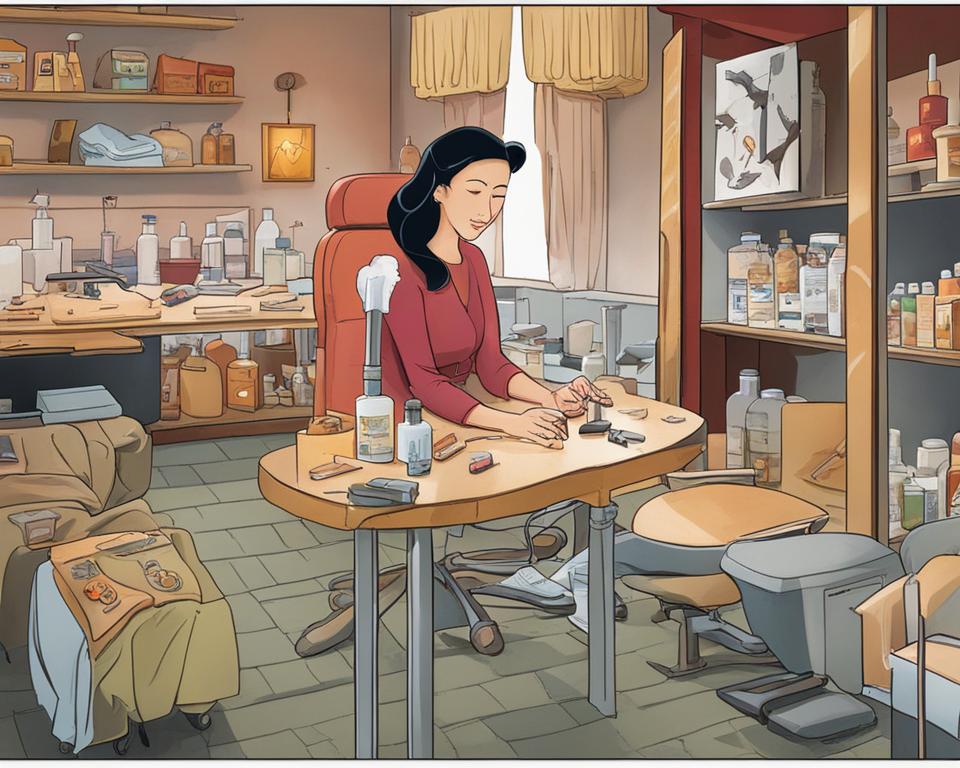If you’ve ever experienced nail pain, you know how uncomfortable and distracting it can be. But have you ever wondered why your nails hurt? Nail pain can be caused by a variety of factors, from common issues like hangnails and infections to more serious conditions. Understanding the causes of nail pain and how to maintain nail health is essential for keeping your nails pain-free and healthy.
In this article, we will delve into the common causes of nail pain, explore how specific nail pain locations can indicate underlying issues, discuss the potential pain from manicures and nail polish, and provide tips for treating and preventing nail pain. By the end, you’ll have a comprehensive understanding of nail health and how to keep your nails in tip-top shape.
Key Takeaways:
- Nail pain can be caused by various factors, including infections, ingrown nails, and physical injuries.
- The location of the nail pain can provide insights into the underlying cause.
- Manicures, nail polish, and acrylic nails can sometimes lead to nail pain if not used or applied properly.
- Treating nail pain may involve home remedies or medical treatment, depending on the severity.
- Preventing nail pain involves maintaining good nail hygiene and using gentle nail care practices.
Common Causes of Nail Pain
Nail pain can be caused by various conditions and factors. Understanding the common causes of nail pain is essential for identifying and treating the underlying issues. Here are some of the most prevalent causes:
Nail Infection
A nail infection, such as paronychia or a fungal nail infection, can lead to pain, swelling, and discoloration of the nails. These infections are often caused by bacteria or fungi entering the nail through breaks or cuts in the skin around the nails. Prompt treatment is crucial to prevent the infection from spreading.
Ingrown Nail
An ingrown nail occurs when the edge of the nail grows into the skin, causing pain, redness, and swelling. This condition is commonly seen in toenails and can be caused by improper nail trimming, tight-fitting shoes, or trauma to the nail. Soaking the affected area in warm water and wearing proper footwear can help alleviate the pain.
Hangnail
A hangnail is a small piece of torn skin at the edge of the nail. It can cause discomfort and pain, especially when pressure is applied. Hangnails can be caused by dry skin, nail biting, or aggressive manicure procedures. Proper nail hygiene and moisturizing the hands can prevent hangnails.
Physical Injury
Physical injuries, such as slamming a finger in a door or dropping a heavy object on the nail, can cause acute nail pain. These injuries can result in bruising, bleeding, or even a fractured nail. Applying ice and keeping the finger elevated can help reduce pain and swelling.
Nail Biting
Individuals who have a habit of nail biting can experience pain and soreness in the nails and cuticles. Nail biting can lead to infections and damage to the nail bed. Breaking the habit and practicing stress-relieving techniques can help prevent nail pain.
Nail Abnormality
Nail abnormalities, such as pitting, ridges, or thickening of the nails, can cause discomfort and pain. These abnormalities can be a sign of an underlying health condition or nutritional deficiency. Seeking medical advice and addressing the underlying cause is essential for relieving nail pain.
Understanding the common causes of nail pain is the first step towards effective treatment and prevention. By taking care of your nails and seeking appropriate medical attention when necessary, you can maintain healthy and pain-free nails.
Understanding Specific Nail Pain Locations
The location of nail pain can provide valuable insights into the underlying cause. Different areas of the nail, such as the side or corner, the nail bed, or the cuticles, can experience pain for various reasons.
Pain in the Side or Corner of the Nail
Pain in the side or corner of the nail can be caused by several factors:
- Hangnails: These are small, torn pieces of skin at the edge of the nail. When they become inflamed or infected, they can cause pain.
- Nail Biting: Biting your nails can lead to damage and pain in the surrounding skin and cuticles.
- Ingrown Nails: When the edge of the nail grows into the surrounding skin, it can result in pain and inflammation.
- Injuries: Accidents or trauma to the nail can cause pain in the side or corner.
- Infections or Abnormalities: Nail infections or abnormalities can also contribute to pain in this area.
Nail Bed Pain
Pain in the nail bed can be caused by a variety of factors:
- Infections: Bacterial or fungal infections affecting the nail bed can cause pain and discomfort.
- Fungal Nail Infections: These infections can affect the nail bed, leading to pain and nail discoloration.
- Injuries: Trauma or injuries to the nail can result in pain in the nail bed.
- Abnormalities: Anatomical abnormalities or nail deformities can contribute to pain in the nail bed.
Cuticle Pain
Cuticle pain can occur due to several reasons:
- Nail Biting: Biting or picking at the cuticles can cause pain and irritation.
- Hangnails: Hangnails, especially when torn or infected, can lead to pain in the cuticle area.
- Injuries: Cuts, abrasions, or injuries to the cuticles can result in pain.
- Infections or Abnormalities: Infections, such as paronychia, fungal nail infections, or underlying nail abnormalities, can cause pain in the cuticles.
Understanding the specific locations of nail pain can assist in identifying the cause and seeking appropriate treatment. It is crucial to consult a healthcare professional if you experience persistent or severe nail pain.
Visual Representation of Common Nail Pain Locations
| Pain Location | Possible Causes |
|---|---|
| Side or Corner of the Nail |
|
| Nail Bed |
|
| Cuticles |
|
Note: This table provides an overview of common nail pain locations and their possible causes.
Nail Pain from Manicures and Nail Polish
Getting a manicure is a great way to pamper yourself and make your nails look fabulous. However, it’s not uncommon to experience nail pain after getting your nails done or applying nail polish. Understanding the potential causes of this discomfort can help you address the issue effectively.
The use of certain chemicals in gel manicures, such as UV light and strong adhesives, can sometimes lead to nail pain and irritation. Additionally, exposure to nail polish and nail polish remover containing harsh chemicals can also cause discomfort. These chemicals can strip the natural oils from your nails and dry them out, resulting in pain and sensitivity.
Another factor that can contribute to nail pain is the application of acrylic nails. While acrylic nails can enhance the appearance of your nails, improper application or maintenance can lead to damage and discomfort. For instance, if the acrylic nails are too tight or if they are applied too close to the nail bed, they can cause pressure and pain.
To prevent nail pain from manicures and nail polish, consider the following tips:
- Choose a reputable salon or nail technician who prioritizes nail health.
- Opt for gel manicures that use LED light instead of UV light.
- Use nail polish and nail polish remover that are free from harsh chemicals, such as formaldehyde and toluene.
- Avoid applying acrylic nails yourself and ensure they are properly applied and maintained.
- If you experience nail pain or discomfort after a manicure or nail polish application, remove the polish and give your nails a break to allow them to recover.
Treating and Preventing Nail Pain
When it comes to nail pain, finding the right treatment and preventive measures can make all the difference. Depending on the underlying cause, there are various approaches to relieve pain and promote optimal nail health. Here are some effective strategies:
Treating Nail Pain
If you’re experiencing nail pain due to ingrown nails, infections, or fungal nail infections, there are several home remedies that can provide relief. Try the following:
- Soak your affected nails in warm water for 10-15 minutes daily to soften the nails and reduce inflammation.
- Apply a topical cream or ointment recommended by a healthcare professional to alleviate pain and fight off infections.
While these remedies may be helpful for mild cases, it’s important to consult a healthcare professional for severe cases or persistent pain. They can provide proper medical treatment based on the specific condition and its severity.
Preventing Nail Pain
Prevention is key to maintaining healthy nails and preventing nail pain. Incorporate the following nail care tips into your routine:
- Maintain good nail hygiene by keeping your nails clean and dry. Trim them regularly to avoid ingrown nails and infections.
- Avoid nail-biting, as it can cause damage to the nails and increase the risk of infections.
- Wear proper footwear that fits well, as tight or ill-fitting shoes can put pressure on the nails and lead to pain.
- Use gentle nail care practices, such as avoiding excessive filing, harsh nail polish removers, and aggressive cuticle cutting.
By following these preventive measures, you can minimize the chances of experiencing nail pain and promote overall nail health.
| Treatment | Pros | Cons |
|---|---|---|
| Home Remedies | – Convenient and cost-effective – Can be effective for mild cases |
– Limited effectiveness for severe cases – May take time to see results |
| Medical Treatment | – Provides expert guidance and treatment options – Effective for severe or persistent pain |
– May involve higher costs – Potential side effects |
Conclusion
Understanding the causes of nail pain and taking steps to maintain nail health is essential for preventing and treating this common issue. By following good nail hygiene practices and seeking appropriate treatment when needed, you can keep your nails healthy and pain-free.
Maintaining nail health starts with proper care and attention. Regularly trimming and shaping your nails, avoiding nail-biting, and using gentle nail care practices can help prevent nail pain. Additionally, wearing comfortable and well-fitting footwear can reduce the risk of physical injury to your nails.
It is also crucial to address any underlying issues that may lead to nail pain, such as nail infections or abnormalities. Seeking professional medical advice and treatment when necessary can help alleviate pain and promote nail health.


